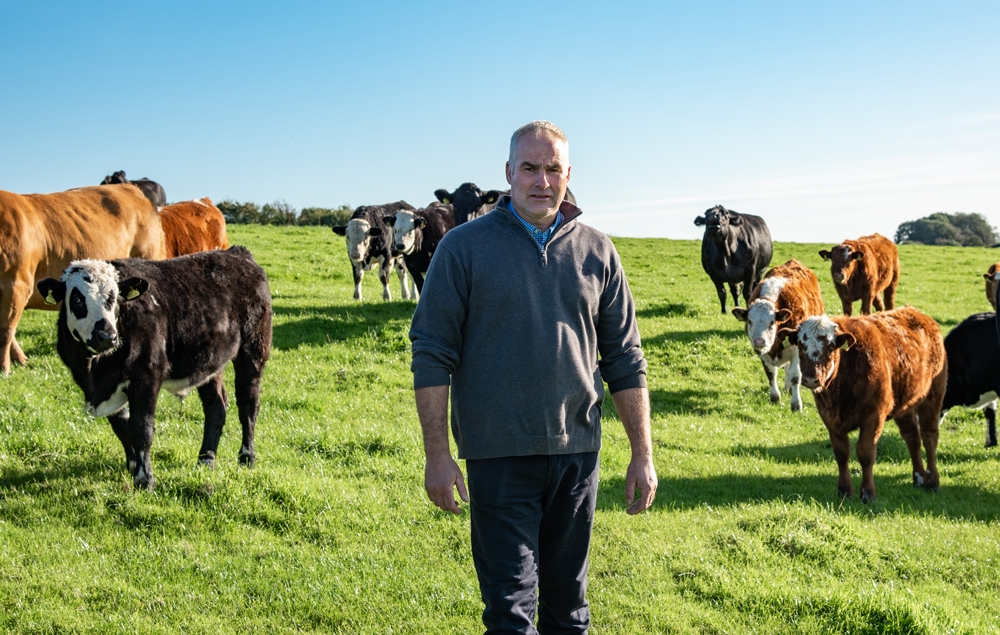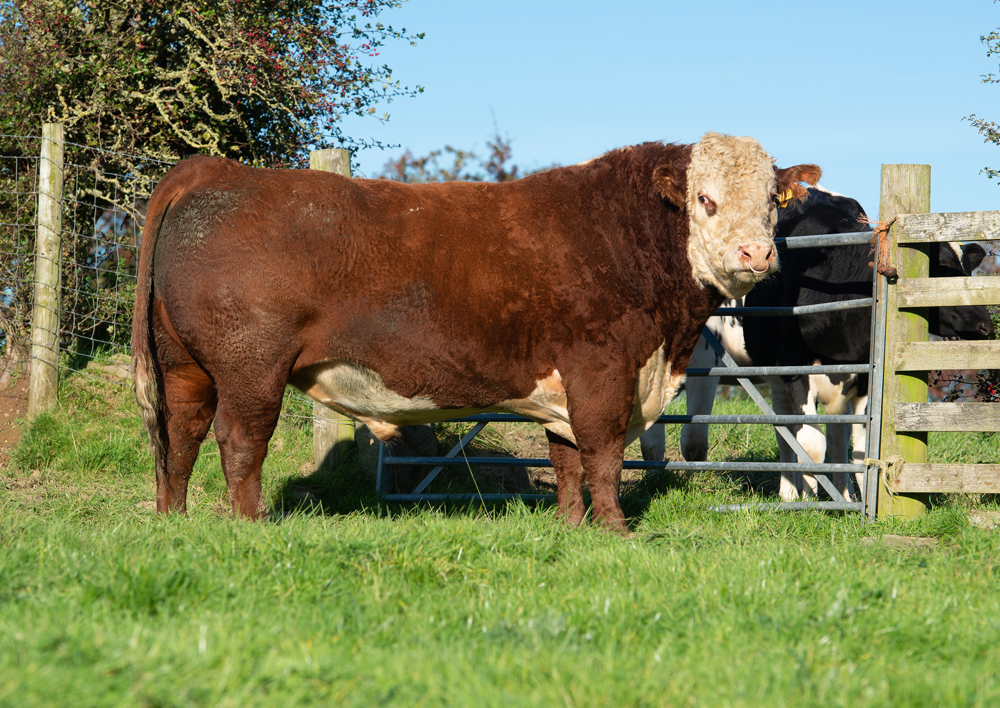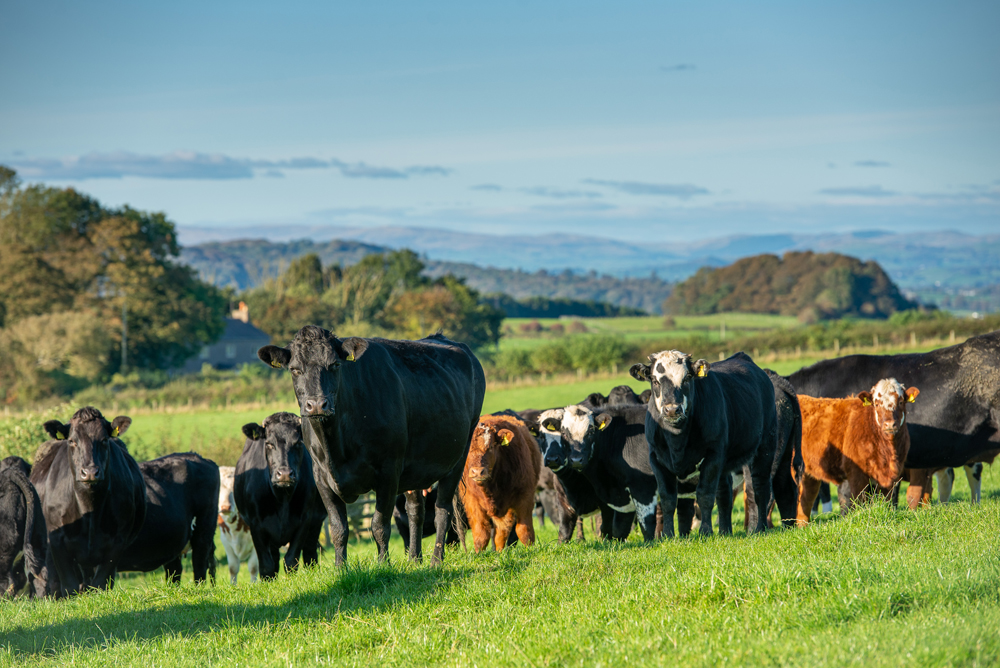

Alan Riley
Costs have been significantly reduced, the calving jack is covered in cobwebs, and the management of his commercial suckler herd has been simplified for north Lancashire foot trimmer Allan Riley with the purchase last year of a quality Hereford bull.
For almost 30 years Allan Rilley has run spring calving suckler cows alongside his foot trimming and freeze branding business, but with the latter taking him and his team off-site for most of the day, problems at calving time are the last thing he needs. However, because his income from the sucklers comes from selling weaned calves as stores, cost of rearing and quality remain vitally important.
The family business, based at Westfield Farm, Nether Kellett, comprises around 49 hectares (120 acres) of owned and rented land, and is an all-grass farm just a few hundred feet above sea level. It is free-draining land with all fields mowable and Allan runs 30 cows, mainly black Limousin-dairy crosses. He also helps his father when required with his pedigree Suffolk and commercial sheep.
Traditionally a Limousin bull has been used, and Allan sells the majority of his stores through the ring in Lancaster, but this year was his first year calving to the Hereford. It is an impressive four year old ET American line-bred bred bull from the Netherhall pedigree herd of one his foot trimming clients, the Kelly family at Kirkby Lonsdale.
Says Allan: “I am certainly not decrying the Limousin in any way, but all I can say in this our first year of using the Hereford, is how much easier it has made things and how pleased I am with the calves. They have good length, decent conformation and all our cows calved within a three week period, outside and unaided, and with no losses.”
He also feels that a stress-free calving helps the cows begin cycling again and therefore maintain a tight calving period.
“Taking into account my vet bills in previous years, the cost of having to buy the odd replacement calf following a loss at calving, plus the bill for creep feed, I reckon the business should be more profitable now with our Hereford-sired stores which will have performed almost entirely off grass and forage.”
All but two of the current herd are the Limousin crosses, the other two being three quarter-bred Limousins.
“I like the temperament and milkiness of these dairy crosses, most of which I tend to buy privately from high health status herds which I visit for foot trimming. However, the cows themselves must have good conformation and the Hereford bull I bought, Nertherhall L1 Maybe, has a plus EBV for milk (+16kg) and the plan is to retain some of his heifers and put them back to a Limousin bull. All the male calves are ringed as finisher buyers like to graze them,” he says.
He also has a few British Blue heifers on rented ground away from the farm and these will also be put to the Hereford bull.
“On my farm visits, it is clear that the Hereford is becoming more popular on dairy herds, along with, to be fair, the Angus. I am sure that one reason for this, apart from calving ease, is the improvement we have seen in the Hereford breed with better conformation, lighter bone, shorter gestation but retaining that ability to perform off grass,” says Allan.
“I look for good length and loin in a bull because that tends to be what the abattoirs are paying on these days and there seems to be less emphasis on the back-end producing roasts which are often discounted on the supermarket shelves.

Four year old Netherhall L1 Maybe MO74
“As for the cows, I keep them as long as they are efficient and while some of my planned expansion up to 50 head will come from retained, Hereford-sired heifers, I will still continue to source these black females as replacements like I have always done.”
The system at Westfield Farm is quite simple and although there has been a change of herd sire, will remain pretty much the same apart from one important difference, outdoor calving.
“Previously we have kept the cows inside until calving simply because, if there was a problem and a cow needed assistance in one way or another, I am away from the farm for much of the day so it was easier to handle them. This year they all calved outside and I think with the cows moving around more, the unborn calf positions itself better. I am not saying it will always be so, everybody gets problems occasionally, but based on our experience this year, it will be outdoor calving from now on. Cost considerations aside, it means we are better able to get on with the foot trimming which is the main side of my business.”
The cows have access to pre-calver buckets for three months but the spring-born calves weighing 30-40kg at birth receive no creep at grass, with Allan a big believer in the suckler cows’ milkiness. In previous years the continental cross calves received creep in the field from July. The herd is normally housed in mid-October when everything is fluked and wormed and the calves do then have access to creep feed before weaning at Christmas after which they just receive a small amount of feed – less than one kg — once a day in addition to conserved forage. The target weight for weaning, depending on whether they are males or heifers, is either side of half the weight of the cow and they are weaned into pens in the same building as the cows.
“The do bawl for a couple of days after they have been weaned, but generally I think this puts less stress on them than total separation,” he says.
Allan employs two staff on the foot trimming side – John Barton full time, and Joseph Ibbetson on a part-time basis – and this does enable him to spend a little more time on the farm. The trimming crush is a KVK Danish-manufactured hydraulic unit powered by mains where available, or four on-board batteries.
It was when he was trimming at David and Maggie Kelly’s he was persuaded to give the Hereford a try, the Kellys already having switched from pedigree continentals and proved to themselves the benefits of concentrating on Hereford EBVs, easy calving and growth rates. Allan had also noticed a significant improvement in foot health in their herd and ironically, a requirement for fewer visits from himself.
“There definitely is a big difference in the amount of attention needed by continental and native breeds. I don’t really know why, but I do know that ‘pushing’ cattle on concentrates has a detrimental effect on feet.”
However, he is keen to dispel one myth relating to hoof colour.
“I know some people maintain that black hooves are more durable and require less attention, but in my experience that is simply not the case. We trim pedigree bulls of all breeds and when you get animals that have not been on large amounts of hard feed, they are definitely better on their feet whatever the colour,” he says.
There is no hard feeding at Westfield Farm and nor is there any emphasis on high protein content forage.
“We make hay and haylage but we don’t cut young grass as I believe high protein forage can tend to put too much growth into the unborn calf and therefore increase the risk of calving issues,” says Allan.
Stores destined for sale will not be turned out before selling although he does intend to sell the Hereford crosses a little older than he did the Limousins.

Allan is happy with the conformation of the Hereford cross calves
“We used to sell from about nine to eleven months old but now it will be from 11 to 15 months, with most through the auction and a few private sales and they will be sold with named sire on the passports as some of my buyers will be targeting the retailer native premium schemes,” says Allan.
Breedplan figures for Netherhall L1 Maybe show him +57kg 400 day weight and +68kg 600 days with calving ease (daughters) +1.9 per cent.
The Netherhall sire itself will be retained as long as it is producing the goods, but Allan says he would be very interested in taking a son of an Australian bull from which the Kellys have been using semen.
“I have seen the Australian bull on video link and I am extremely impressed with him,” says Allan. “It is my type of bull.”
Farm facts:
• 49 hectares (120 acres) of grass
• Currently 30 Limousin cross dairy suckler cows
• High health BVD Lepto-free herd
• Spring calving to Hereford bull
• Milkiness of cows a priority
• Progeny sold as store steers, auction and private
• Some heifers being retained for herd expansion
• Emphasis on grass and low protein forage
• Minimal creep feed
